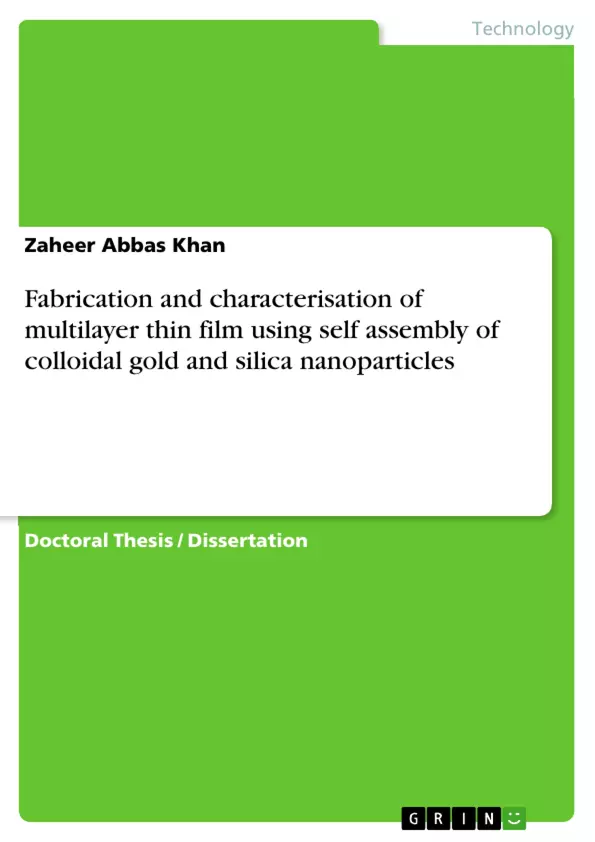A novel approach of multilayered thin film based on layer-by-layer deposition using colloidal nanoparticles was carried out in this work. The films were made by the self-assembly of oppositely charged metal and dielectric nanoparticles, alternately capped with polymers. Synthesized colloidal suspensions of gold nanoparticles (~20nm) and silica nanoparticles (~30nm) were used as the building blocks for the self-organisation of the films. Capping with PDDA and chitosan was used effectively to control the optical absorption of the surface plasmon resonance peaks of the gold nanoparticles. Using different combinations of layer formation, absorption characteristics in the near-ultraviolet (NUV), green and blue region were controlled through capping and varying the thickness of the film. Capping with chitosan or PDDA reduced the absorption peak of the coated silica nanoparticles in a similar fashion. Peak absorption in the UV range was achieved by assembling bare silica nanoparticles layers onto layers of gold nanoparticles. Transmission color was controlled (less than 1% color distance per added bi-layer) by changing the film thickness.
Optical modeling of multilayer thin films constructed with oppositely charged nanoparticles helped us to understand phenomenon such as surface plasmon resonance, absorbance, transmittance and reflectance. Maxwell-Garnett effective medium theory in this case is applied in quasi-static limit to multilayer composite consisting of host material silica and inclusion material gold nanoparticles. Maxwell Garnett optical simulations is correlated with experimental spectra obtained for the thin film composites. The thickness of layers, size and spacing of metal inclusion is varied to alter the optical properties for the required device applications.
The multilayered thin film of gold and silica resembles a structure consisting of large charge sheets of metal separated by a dielectric layer. When the applied electric potential reaches a threshold value, it drives the electrons to tunnel through the charge sheets producing a rectification effect. Therefore current-voltage measurements of the multilayer thin films were performed to calculate the threshold voltages. The electrical capacitance in these multilayer devices was modified with the change in thickness of the dielectric layers between two conducting layers and calculated by capacitance-voltage measurements of multilayer stack. [...]
Inhaltsverzeichnis (Table of Contents)
- Introduction
- Background
- Statement of the problem
- Objective of research work
- Hypothesis
- Scope and limitations of research work
- Organization of the research thesis
- Literature Review
- 'Top-down' versus 'bottom-up' assembly
- Colloidal nanoparticles
- Colloidal gold nanoparticles
- Colloidal silica nanoparticles
- Polyelectrolytes
- Chitosan
- PDDA poly(diallyldimethylammonium chloride)
- Surface passivation of colloidal nanoparticles
- Stabilisation of nanoparticles
- Electrostatic stabilisation
- Steric stabilisation
- Surface plasmon resonance
- Layer-by-layer self assembly
- The forces guiding colloidal assembly
- The role of pH buffers
- The formation and structure of thin films
- Wettability of thin films
- Electrical properties of metal-insulator films
- Quantum tunneling
- Fowler-Nordheim (F-N) tunneling
- Thermal properties of thin films
- Optical properties of thin multilayered structures
- Effective medium theory
- Maxwell-Garnett model
- Thin film optical filter
- Methodology
- Synthesis of colloidal nanoparticles
- Surface passivation of colloidal nanoparticles using different polymers
- Synthesis and surface modification of gold nanoparticles
Zielsetzung und Themenschwerpunkte (Objectives and Key Themes)
This dissertation investigates the fabrication and characterization of multilayer thin films using colloidal gold and silica nanoparticles. The primary objective is to explore the self-assembly process of these nanoparticles, focusing on the control of optical and electrical properties through layer-by-layer deposition. The study utilizes polymers for surface passivation and explores the influence of different combinations of layer formation on the optical absorption characteristics.
- Self-assembly of colloidal nanoparticles for multilayer thin film fabrication
- Control of optical properties through surface passivation and layer thickness variation
- Investigation of electrical properties and tunneling behavior in multilayer structures
- Optical modeling and simulation using effective medium theory
- Correlation of experimental results with theoretical models
Zusammenfassung der Kapitel (Chapter Summaries)
The introductory chapter establishes the research context, outlines the problem statement, and details the objectives, hypothesis, scope, and organization of the dissertation. The literature review comprehensively examines existing knowledge regarding 'top-down' and 'bottom-up' assembly techniques, colloidal nanoparticles, polyelectrolytes, surface passivation, stabilization mechanisms, surface plasmon resonance, layer-by-layer self-assembly, forces guiding colloidal assembly, pH buffers, thin film properties, electrical properties, quantum tunneling, Fowler-Nordheim tunneling, thermal properties, optical properties, effective medium theory, and the Maxwell-Garnett model. The methodology chapter describes the detailed experimental procedures, including the synthesis of colloidal nanoparticles, surface passivation using different polymers, and the synthesis and surface modification of gold nanoparticles.
Schlüsselwörter (Keywords)
This dissertation focuses on the fabrication and characterization of multilayer thin films using colloidal gold and silica nanoparticles. Key themes include layer-by-layer self-assembly, surface plasmon resonance, optical properties, electrical properties, tunneling behavior, effective medium theory, Maxwell-Garnett model, and the control of thin film properties through surface passivation and layer thickness variation.
- Quote paper
- Dr Zaheer Abbas Khan (Author), 2011, Fabrication and characterisation of multilayer thin film using self assembly of colloidal gold and silica nanoparticles, Munich, GRIN Verlag, https://www.grin.com/document/334799



